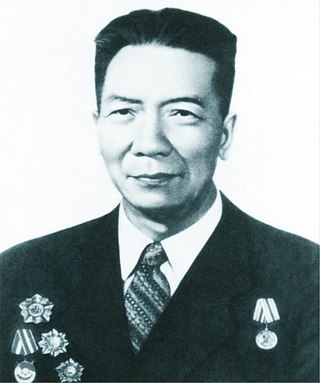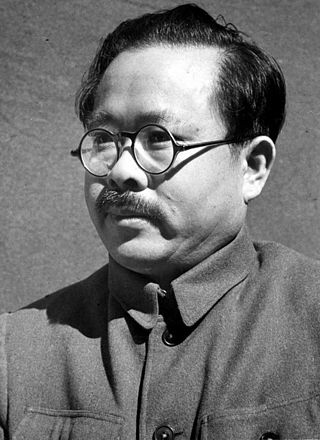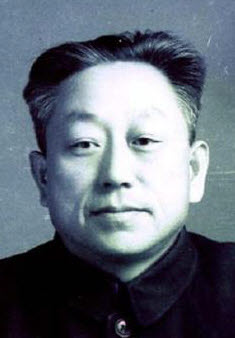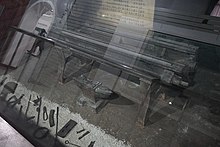
Zhou Enlai was a Chinese statesman, diplomat, and revolutionary who served as the first Premier of the People's Republic of China from September 1954 until his death in January 1976. Zhou served under Chairman Mao Zedong and aided the Communist Party in rising to power, later helping consolidate its control, form its foreign policy, and develop the Chinese economy.

The Chinese Civil War was fought between the Kuomintang-led government of the Republic of China and forces of the Chinese Communist Party, with armed conflict continuing intermittently from 1 August 1927 until 7 December 1949, and ending with Communist control of mainland China.

The Second Sino-Japanese War was a military conflict primarily between the Republic of China and the Empire of Japan from 1937 to 1945, as part of World War II. In China, the war is called the War of Resistance against Japanese Aggression. This total war between China and the Empire of Japan is often regarded as the beginning of World War II in Asia, although some scholars consider the European War and the Pacific War to be entirely separate, albeit concurrent. It was the largest Asian war in the 20th century and has been described as "the Asian Holocaust", in reference to the scale of Imperial Japan's war crimes against Chinese civilians. After the Japanese attacks on Malaya and Pearl Harbor in 1941, the war merged with other conflicts which are generally categorized under the China Burma India Theater of World War II.

Sanzō Nosaka was a Japanese writer, editor, labor organizer, communist agent, politician, and university professor and the founder of the Japanese Communist Party (JCP). He was the son of a wealthy Japanese merchant, and attended the prestigious Keio University. While in university, Nosaka became interested in social movements, and joined a moderate labor organization after graduation, working as a research staff member, and as a writer and editor of the organization's magazine. He traveled to Britain in 1919 to study political economy, where he deepened his studies of Marxism and became a confirmed communist. Nosaka was a founding member of the Communist Party of Great Britain, but his activity within British communist circles led to him being deported from Britain in 1921.

Zhao Shangzhi was a Chinese military commander. Born into a peasant-turned-intellectual family in Chaoyang, Liaoning, he participated in the May Thirtieth Movement in 1925, and joined the Communist Party of China in the same year. In November 1925, he went to study in the Whampoa Military Academy in Guangzhou.

Wang Ming was a senior leader of the early Chinese Communist Party (CCP) and the mastermind of the famous 28 Bolsheviks group. Wang was also a major political rival of Mao Zedong during the 1930s, opposing what he saw as Mao's nationalist deviation from the Comintern and orthodox Marxist–Leninist lines. According to Mao on the other hand, Wang epitomized the intellectualism and foreign dogmatism Mao criticized in his essays "On Practice" and "On Contradiction". The competition between Wang and Mao was a reflection of the power struggle between the Soviet Union, through the vehicle of the Comintern, and the CCP to control both the direction and future of the Chinese revolution.

Xiang Zhongfa was a Chinese socialist who was one of the early senior leaders of the Chinese Communist Party (CCP).

The Empire of Japan's Kwantung Army invaded Manchuria on 18 September 1931, immediately following the Mukden Incident. At the war's end in February 1932, the Japanese established the puppet state of Manchukuo. Their occupation lasted until the success of the Soviet Union and Mongolia with the Manchurian Strategic Offensive Operation in mid-August 1945, towards the end of the Second World War.
The Defense of Harbin occurred during the early Second Sino-Japanese War, as part of the campaign of the Invasion of Manchuria by forces of the Empire of Japan from 25 January to 4 February 1932.

The Pacification of Manchukuo was a Japanese counterinsurgency campaign to suppress any armed resistance to the newly established puppet state of Manchukuo from various anti-Japanese volunteer armies in occupied Manchuria and later the Communist Northeast Anti-Japanese United Army. The operations were carried out by the Imperial Japanese Kwantung Army and the collaborationist forces of the Manchukuo government from March 1932 until 1942, and resulted in a Japanese victory.

Zhou Baozhong was a commander of the 88th Separate Rifle Brigade and Northeast Anti-Japanese United Army resisting the pacification of Manchukuo by the Empire of Japan.

Yang Jingyu, born Ma Shangde, was a Chinese communist, military commander and political commissar who led the First Route Army of the Northeast Anti-Japanese United Army during the Second Sino-Japanese War. His troops waged a guerrilla war against Japanese forces in Manchukuo (Manchuria) who were attempting to suppress resistance in the region.
The Inner Mongolian campaign in the period from 1933 to 1936 were part of the ongoing invasion of northern China by the Empire of Japan prior to the official start of hostilities in the Second Sino-Japanese War. In 1931, the invasion of Manchuria secured the creation of the puppet state of Manchukuo and in 1933, Operation Nekka detached the province of Rehe from the Republic of China. Blocked from further advance south by the Tanggu Truce, the Imperial Japanese Army turned its attention west, towards the Inner Mongolian provinces of Chahar and Suiyuan, with the goal of establishing a northern China buffer state. In order to avoid overt violation of the Truce, the Japanese government used proxy armies in these campaigns while Chinese resistance was at first only provided by Anti-Japanese resistance movement forces in Chahar. The former included in the Inner Mongolian Army, the Manchukuo Imperial Army, and the Grand Han Righteous Army. Chinese government forces were overtly hostile to the anti-Japanese resistance and resisted Japanese aggression only in Suiyuan in 1936.
Li Yanlu, 李延禄, (1895–1985), soldier, communist, and leader of anti-Japanese forces in Manchuria. Li was born in Yenchi, Kirin Province, in April 1895. He became involved in the opposition to Yuan Shikai's attempt to restore the monarchy. He joined the Fengtian Army in 1917, as a private soldier and rose to platoon leader, then captain over the next sixteen years. Politically, he moved to the left and in July 1931, he joined the Communist Party of China. Three months later, the Japanese began the Mukden Incident and invasion of Manchuria. Avoiding capture and internment by the Japanese, he joined the volunteer army of Wang Delin. There, Communists were welcomed and Li and Zhou Baozhong were made high-ranking officers. Li became the chief of staff of Wang's Chinese People's National Salvation Army, one of the most successful of the volunteer armies resisting the Japanese and its puppet state of Manchukuo. He was also said to have been secretly organizing communists within the army. Yet Party policy at the time opposed the volunteer armies and the participation of members in them and had their own Northeastern People's Revolutionary Army. At first, the Party severely criticised their conduct yet the stance of the Party prevented the growth of their own forces and did not help the anti-Japanese cause.
The League against Imperialism and Colonial Oppression was a transnational anti-imperialist organization in the interwar period. It has been referenced as in many texts as World Anti-Imperialist League or simply and confusingly under the misnomer Anti-Imperialist League.
The history of the Chinese Communist Party began with its establishment in July 1921. A study group led by Peking University professors Chen Duxiu and Li Dazhao to discuss Marxism, led to intellectuals officially founding the Chinese Communist Party (CCP) in July 1921. In 1923, Sun Yat-sen invited the CCP to form a United Front, and to join his Nationalist Party (GMD) in Canton for training under representatives of the Communist International, the Soviet Union's international organization. The Soviet representatives reorganized both parties into Leninist parties. Rather than the loose organization that characterized the two parties until then, the Leninist party operated on the principle of democratic centralism, in which the collective leadership set standards for membership and an all powerful Central Committee determined the party line, which all members must follow.

Ren Bishi was a military and political leader in the early Chinese Communist Party (CCP).

The Museum of the War of Chinese People's Resistance Against Japanese Aggression or Chinese People's Anti-Japanese War Memorial Hall is a museum and memorial hall in Beijing. It is the most comprehensive museum in China about the Second Sino-Japanese War.

Zhu Dehai was a Korean Chinese revolutionary, educator, and politician of the People's Republic of China. He served as a political commissar of the Eighth Route Army during the Second Sino-Japanese War. He was the first governor of Yanbian Korean Autonomous Prefecture from 1952 to 1965. He also served as the member of the National People's Congress (NPC) for several years. He was known as a political moderate and defied orders from the during the Great Leap Forward while maintaining a close relationship with the North Korean government. During the Cultural Revolution, the Red Guards stigmatized Zhu as a North Korean spy, and he was expelled from all political positions.
The Minsaengdan incident, or Min-Sheng-T'uan Incident, was a series of purges occurring between 1933 and 1936 in which the Chinese Communist Party (CCP) arrested, expelled, and killed Koreans in Manchuria, based on the suspicion that the purged Koreans were supporting the Japanese occupiers as part of the pro-Japanese and anti-communist group, Minsaengdan. The CCP arrested and expelled over 1,000 of its Korean members and killed 500 during the purges. Korean guerilla leader and future founder of North Korea Kim Il Sung was arrested and then exonerated during the purges and his opposition to the purges became an important factor in solidifying his leadership among the guerillas opposing the Japanese occupation.

















